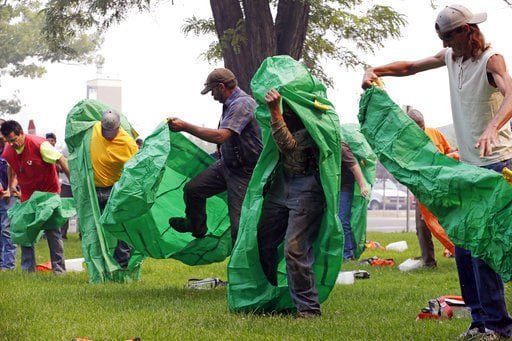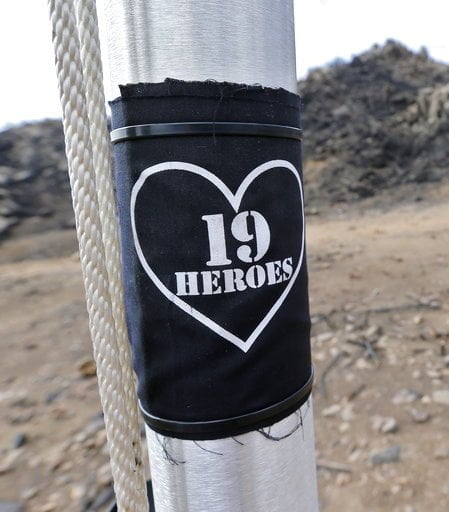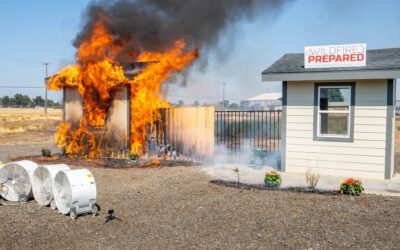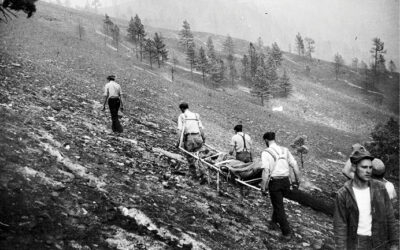Improvement efforts unable to meet deadline

FILE – In this Aug. 22, 2015, file photo, volunteers learn to deploy fire shelters with practice equipment after a call out by fire officials seeking to supplement their usual resources in Omak, Wash. Wildland firefighters will have to wait at least an extra year before getting better fire shelters than the ones that failed to save the Arizona 19 firefighters. The U.S. Forest Service’s expedited attempt following those deaths to have an upgraded shelter later this year is being pushed back a year after nearly 100 prototypes couldn’t outperform the current shelter developed in 2002. (AP Photo/Elaine Thompson, File)
KEITH RIDLER, Associated Press
BOISE, Idaho (AP) — Crews who battle wildfires will have to wait at least another year before getting better fire shelters than those that failed to save 19 firefighters trapped by flames in Arizona four years ago, officials told The Associated Press on Thursday.
The deaths pushed the U.S. Forest Service to speed up work to get an upgraded shelter in place this year, but the effort has been delayed a year after prototypes could not outperform the shelter developed in 2002.
It comes as firefighters are facing more destructive wildfires and the struggle to protect more homes being built in or near remote areas.
“The reason there isn’t (a new shelter) is because there were no great options to choose from,” said Tony Petrilli, fire shelter project leader for the U.S. Forest Service at the Missoula Technology and Development Center in Montana.
Petrilli escaped serious injury or death by getting into a fire shelter as flames roared past on Colorado’s Storm King Mountain in 1994. His elation at emerging a survivor didn’t last long.
Within minutes, he was among the first to find the bodies of some of the 14 firefighters whose fire shelters didn’t save them. His radio message reporting the deaths rattled federal agencies and led to the development of the 2002 shelter.
The Forest Service wants to replace that shelter following the 2013 deaths in Arizona. Those two fires are among the deadliest for wildland firefighters in U.S. history and the worst since fire shelters became mandatory in 1977.

FILE – In this July 23, 2013, file photo, a “19 Heroes” patch is attached to a flagpole at the site where 19 firefighters died battling an Arizona wildfire on June 30, in Yarnell, Ariz. Wildland firefighters will have to wait at least an extra year before getting better fire shelters than the ones that failed to save the Arizona 19 firefighters in 2013. The U.S. Forest Service’s expedited attempt following those deaths to have an upgraded shelter later this year is being pushed back a year after nearly 100 prototypes couldn’t outperform the current shelter developed in 2002. (AP Photo/Matt York, File)
But the effort faces serious setbacks, and the agency says it won’t meet its December deadline to create an upgraded shelter for the 2018 fire season despite help from NASA, research universities and private companies.
After spending roughly $200,000 to $500,000 on the program, it’s possible the 2002 shelter will stay the standard, the Forest Service said.
“We’re not having a whole lot of success,” said Mark Ackerman, a former academic at the University of Alberta in Edmonton, Alberta. He helped develop the 2002 shelter and is helping the government test new designs to replace it. “Based on what we’re seeing now, I don’t think the game-changer is there.”
But several promising materials that showed up recently remain, and the extra year will allow time for testing, Petrilli said.
Scientists need to create a shelter that can repel radiant heat, which is felt standing near flames, and convective heat, felt if you put a hand into the fire.
Today’s shelters reflect 95 percent of radiant heat, and firefighters have survived in them for an hour with brief exposure to direct flames. The challenge is making them last as fire burns around them.
The shelter Petrilli used in 1994 could last only seconds in direct flames. The current 4.5-pound (2-kilogram) shelter with an aluminum foil-woven silica outer shell can withstand direct flames and 2,000 degrees (1,090 Celsius) for about a minute.
The Forest Service says it could save lives if it can create a shelter of equal weight that can withstand those conditions longer. Ackerman has tried for two minutes, but prototypes have not come close to that.
“What we’re talking about is buying a little more time,” he said.
Based on several years of testing, he estimated that a shelter with double the protection would be double the weight because of added insulation.
That’s a non-starter with frontline firefighters. A survey at the start of the development process found that less than 5 percent wanted to carry a heavier, more protective shelter. About half wanted a lighter shelter with the same protection, and most of the rest wanted a shelter of similar weight with better protection.
Shawna Legarza, director of the Forest Service’s National Fire and Aviation Management Program who spent 20 years battling wildfires, said putting more weight on firefighters, who already carry 40 or 50 pounds, is not an option.
Instead, federal officials have been working to reduce wildfire risks. Former Interior Secretary Sally Jewell warned homeowners who build in wild areas to create rock walls, green grass extending from homes, or rock lawns to stop approaching flames.
“I think we are making some progress across the nation in people making their homes defensible,” Legarza said. “If we have to respond to a wildfire, we’re only going to do it when we can be successful. Our Number 1 thing is our employees.”
One of them, Missoula, Montana-based smokejumper Dan Cottrell, said safety considerations have increased since he started fighting fires in 1995. He said carrying a fire shelter is worth the extra weight.
“People are pretty aware of their limitations, but it’s better than nothing,” he said.
Copyright 2017 The Associated Press. All rights reserved. This material may not be published, broadcast, rewritten or redistributed.




